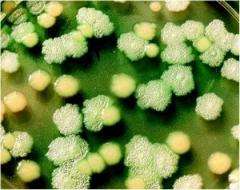Adapting to clogged airways makes common pathogen resist powerful antibiotics

(PhysOrg.com) -- Certain bacteria cause chronic lung infections in people with cystic fibrosis. Surviving in this oxygen-poor, nitrate-rich environment makes the bacteria less susceptible to antibiotics.
People with cystic fibrosis frequently have lung infections that defy treatment. Cystic fibrosis is an inherited disease that clogs airways with thick mucous. While the life expectancy for children with cystic fibrosis has increased over the past few decades, many lives are still shortened in young adulthood by the ravages of lung infections.
These chronic infections are often caused by common, environmental microbes that mutate in ways that let them live and thrive in viscous lung secretions. The same adaptations also make the pathogens less likely to be killed off by powerful antibiotics, according to a recent study led by Dr. Lucas "Luke" Hoffman, University of Washington (UW) assistant professor of pediatrics.
Surprisingly, he added, the pathogens don't need any previous exposure to the antibiotics to resist their effects. The results were published in the latest edition of PLoS Pathogen.
The researchers looked at Pseudomonas aeruginosa, a microbe that can infect a cystic fibrosis patient early in life and then undergo various changes as it establishes a chronic lung infection. Pseudomonas aeruginosa with specific alterations tend to give patients a poor outcome. Some of those alterations diminish the chances of eradicating the infection with antibiotics.
It's believed that these adaptive alterations in Pseudomonas, all of which are caused by genetic changes, could be selected for by the environment inside a patient's airways, the researchers noted. Characteristics that facilitate microbial survival begin to emerge.
The specific airway conditions that select for these genetic changes, Hoffman said, remain unclear. "But," he added, "we have some clues from what is known about airway mucus."
From the point of view of Pseudomonas, the physical properties of cystic fibrosis mucus, Hoffman said, "make it a great place for the stuff people routinely breathe in to set up shop." Cystic fibrosis secretions contain a lot of nitrates and amino acids, which Pseudomonas can use to grow.
Inside mucus plugs oxygen levels are low. Some Pseudomonas strains can live in this oxygen-poor, nutrient-rich environment. Hoffman and his team found that a mutation that occurs commonly in Pseudomonas from cystic fibrosis patients allows the pathogen to grow better in the nutrient environment in cystic fibrosis secretions. This particular mutation inactivates a gene named lasR. Pseudomonas with this mutation apparently undergo a metabolic shift: consuming less oxygen while utilizing nitrate more efficiently. lasR mutant bacteria also can handle oxidative stress resulting from an imbalance of damaging substances called free radicals forming faster than they can be detoxified.
One source of oxidative stress encountered by Pseudomonas is the antibiotic treatment that is frequently given to people who have cystic fibrosis. Antibiotics like ciprofloxacin and tobramycin kill bacteria partly by inducing the overproduction of free radicals and causing oxidative stress. Hoffman and his team found that, because these mutant microbes are resistant to oxidative stress, they were relatively resistant to these antibiotics when grown in conditions that were like cystic fibrosis mucus.
"We learned that simply by adapting to the conditions inside the airways of cystic fibrosis patients, mutated Pseudomonas can withstand the effects of ciprofloxacin and tobramycin," Hoffman said. They did not need any previous exposure to these antibiotics to reduce their susceptibility.
Hoffman and his team suspect that Pseudomonas is not the only microbe that can do this. Some of the characteristics conferred by the mutation in Pseudomonas are also exhibited in other microbes found in chronic lung infections, such as tuberculosis or the fungal pathogen, Cryptococcus neoformans, Hoffman noted. Metabolic shifts may be a way many microbes get the upper hand over their hosts -- and over antibiotics.
This report, Hoffman said, may point to new ideas for treating chronic lung infections. Luckily, colonies of Pseudomonas with the lasR mutation are relatively easy to identify in hospital laboratories by their distinctive iridescent sheen. Because lasR mutant Pseudomonas has been associated with worse outcomes in cystic fibrosis patients, indentifying Pseudomonas with the lasR mutation may be of prognostic value and may indicate the need for treatment with specific antibiotics like monobactams, tetracyclines, or polymyxin, whose mode of action differs from ciprofloxacin and tobramycin. Other treatment methods may be targeted at preventing adaptive changes, such as the lasR mutation, in Pseudomonas, the researchers said.












